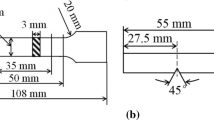Abstract
Fatigue crack growth (FCG) behaviour in both near-threshold and higher stress intensity range (ΔK) in intercritically annealed dual-phase (DP) steel containing martensite between 32% and 76% in ferrite has been studied in 3·5% NaCl solution. It is shown that the amount of martensite content in dual phase steel has a significant effect on threshold (ΔK th) values and FCG rates. Higher content of martensite in ferrite leads to higher threshold values and lower FCG rates. Further, ΔK th is much higher in 3·5% NaCl solution as compared to that in laboratory air. Fractography studies reveal that in the near-threshold region, fracture surfaces are characterized mainly by intergranular cracking in corrosive (3·5% NaCl solution) environment. Higher threshold values in 3·5% NaCl solution is attributed to the higher crack closure induced by rougher fracture surface and by the strong wedge effects of corrosion products.
Similar content being viewed by others
References
Chen D L, Wang Z G, Jiang X X and Shih C H 1987Scr. Metall. 1663
Chen D L, Wang Z G, Jiang X X and Shih C H 1989Mater. Sci. & Engg. 108 141
Liaw P K 1985Acta Metall. 33 489
Pendse D 1985Metall. Trans. A16 1491
Ritchie R O 1979Int. Met. Rev. 20 205
Stewart A T 1980Engg. Fract. Mech. 13 463
Taylor D 1989Fatigue thresholds (UK: Butterworth and Co. Ltd.)
Author information
Authors and Affiliations
Rights and permissions
About this article
Cite this article
Sudhakar, K.V., Bag, A., Dwarakadasa, E.S. et al. Effect of corrosive medium on fatigue crack growth behaviour and fracture in high martensite dual phase steel. Bull Mater Sci 22, 1029–1036 (1999). https://doi.org/10.1007/BF02745616
Received:
Revised:
Issue Date:
DOI: https://doi.org/10.1007/BF02745616




